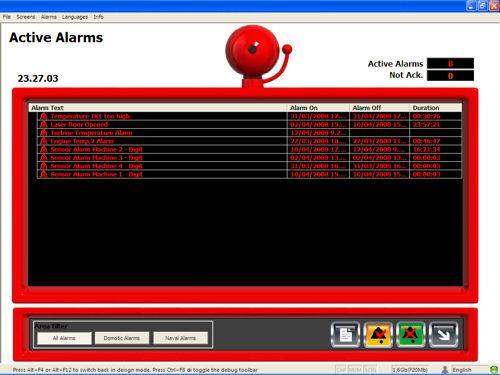
Movicon Help on Line - Rel. 11.7.1301
The Movicon Alarms resource consents the managing of diagnostics and messages in projects.
The diagnostics is one of the fundamental elements on which any supervision application project is based. Basically, the system's task is to generate alarms in relation to variable or logic intervention thresholds.
The Movicon management complies with the ISA (S-18) normative, but is completely configurable to adapt to any application requirement. The project alarms are grouped in objects which are then grouped into thresholds.
Alarm activation can be evoked by a fixed threshold value or by another tag.
The Acknowledge or reset operations on each alarm can be configured, just like the style and functioning modalities can be. The priority levels, which can be assigned to each alarm by the programmer, are virtually unlimited. The Alarms can be grouped into 'Areas' to obtain display filters for the operator or Alarm Window dedicated to each plant sector. The time-stamping is precise and accurate to the millisecond. Movicon also integrates calculated statistics of the alarms with the highest frequency and/or duration in the specified period. Managing alarms in network architectures has been extremely simplified by connecting alarm windows to network stations, or to OPC AE servers.
The alarms also support tag-linked texts, therefore the real values measured at alarm interventions can be displayed and recorded. The alarms also manage SMS, Fax, Email, Speech notifications, through customizable sound files and any kind of intervention, acknowledgement and reset customizing can also be done through the VBA script in response to each alarm event.

|
|
The Movicon alarms can be configured so that they can be acknowledged and reset by the operator before disappearing or they can be linked to the status of a variable only, becoming just simple notification messages. |
The "Alarm Window" window, which can be inserted in any of the project's Screens, is used for viewing the Alarms' situation. The operator can verify and interact with the alarms' situation through this window, evoking the acknowledge or reset commands according to the ISA level 2 norms.
The Alarms can be grouped in one certain area, to allow the Alarm Window to display the alarms relating to a specific logic area of the plant only.
|
|
An Alarm Window can be dedicated to display the remote alarms of a station (Server) connect in net. through the Networking functionalities. |
The displaying of Alarm Window is setup by the project's developer by configuring the window in order to adapt the project to the plant's graphical or functional requirements.
Alarms List Resource
Movicon has a powerful tool for configuring the alarm objects to be managed in the project. The 'Alarms List' is the tool for generating the events which will be represented in the appropriate display windows placed in the Screens.
Each single alarm is considered as an object, which can be completely configured through the 'Properties window'. The property of each single alarm allows you to completely customize both the thresholds and execution functionalities.
An alarm can be associated to a symbol from the "Symbol Library", only if the alarm has not been defined as a "Template", this means that the alarm needs to have been associated to a variable in its "alarm variable" property.
The 'Alarms List' resource is available in the Movicon 'Project Explorer' window.
Scroll Lock Led Key
The "BlinkLedKeyboard" register key can be configured so that any alarm presence still not acknowledged causes the 'Scroll Lock' key to blink on the keyboard. This enables the presence of new alarms to also be seen at a distance.
Alarm Printout Spooler
Movicon manages the printout of alarms and events directly to the printer as they occurs. Please refers to the Project Spooler Manager Settings properties.
Script Code in Alarms
Script code can be associated to each of the alarm's thresholds. For further information please refer to the section on "VBA™ Basic Script in Object and Alarm Code ".